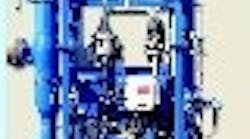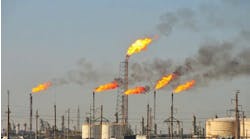By David W. Spitzer, Principal, Spitzer and Boyes
Agars MPFM is a three-phase flow measurement system that provides measurements of oil, water and gas flows simultaneously without completely separating the phases.
CONSIDER the problem of measuring a multi-phase flow stream, where the gas-to-liquid ratio can vary between 0 and 100%, and where pressure, temperature, density, viscosity, and salinity vary as well. Challenging. Yet, in many applications, such as lease allocation of well production, multi-phase flow measurement is required because it costs too much to completely separate the multi-phase stream.
Agars MPFM is a three-phase flow measurement system that provides measurements of oil, water and gas flows simultaneously without completely separating the phases. Most of the incoming gas is separated and measured with a gas flowmeter before exiting the system. The remaining liquid/gas stream is measured with a positive displacement flowmeter and a Venturi flowmeter designed for a low-gas volume fraction. One Agar model eliminates moving parts by replacing the positive displacement flowmeter with two Venturi flowmeters that develop equivalent information about the flow stream. Also, a microwave transmitter can measure the water content in an oil/water stream. The data analysis system then uses these measurements to determine the oil, water, gas and total-fluid flow rates.
Mike Dlugan, production engineer at Nexen in Calgary, Alberta, Canada, helped with a temporary installation of an Agar multiphase flowmeter in a steam-assisted, gravity-drainage (SAGD) tar sands oil production process that operated at 150 C and 5 bar. The installation was easy, Dlugan says, because the location already had power and flanges available to accommodate it. Testing showed the total liquid, total gas, and vapor fraction measurements were accurate over vapor fractions between 40-99%. The inaccuracy in the water-cut measurements was likely due to not having enough time to properly calibrate the instrument, Dlugan adds.
Gordon Stobie, staff flow measurement engineer at ConocoPhillips in Houston, Tex., reports, Conventional well test systems attempt to separate the gas and liquid phases, so they can be measured individually. Not only is this approach expensive, but it involves level and pressure controls that tend to damp the measurement of interestthe flow rates. Another element of the uncertainty in measurement is the level of separation, which may not be as complete as desired. However, multi-phase flow measurement systems make a variety of measurements to determine the fluid flow rates of oil, gas and water, and provide information for improving the wells operation at a fraction of the cost of well-test separation systems. Stobie adds that, unlike multi-phase flowmeters that need well-defined densities and electrical properties for good measurement, Agar multi-phase flowmeter derives fluid density from its measurements.
Parviz Mehdizadeh, consultant at Production Technologies in Phoenix, Ariz., reports, The performance of Agars multi-phase flowmeter compares favorably with other multi-phase flowmeters. This technology allows a degree of self-verification because the individual flowmeters can be checked against each other by flowing a known liquid through the system. In addition, this flowmeter can be used in applications with more than 95% gas volume fraction, which is a challenging regime in multi-phase flow measurement. On the down side, Parviz says positive-displacement flowmeters are subject to blockage and wear. Further, as operating pressures and temperatures increase, the cost and size of the ASME-coded vessels used by the system will increase accordingly.
Patrick Brunings, flow measurement specialist at Staatsolie in Paramaribo, Surinam, has tested two portable Agar multi-phase flowmeters on more than 200 oil wells. Staatsolie operates a field with medium-heavy, foamy oil that makes testing with physical separation very cumbersome. Brunings notes that, These flowmeters have proven to be efficient and reliable in many ways. Compared to tank measurements, Agar multi-phase flowmeters provide more accurate data, more rapidly, and can measure the gas ratios. He adds that maintenance on the units has generally been low.
Testing in a new, multi-well production field in a protected habitat can now be done entirely with fixed, multi-phase flowmeters that will send data via radio transmission, and make it possible to monitor flow from a remote location. These on-line measurements also can help reduce the chances of oil spills in this environmentally sensitive region.
Agar multi-phase meter is unique among its peers because this positive-displacement flowmeters performance is improved as the viscosity of the fluids its measuring increases (reducing fluid slippage), while the associated dual-Venturi design is used to determine the multi-phase fluid density. Therefore, knowledge of well-fluid properties isnt required as long as the flow rates remain within the meter performance envelope.
| About the Author |
David W. Spitzer is a principal at Spitzer and Boyes LLC, which offers consulting services for the process industries. He can be reached at 845/623-1830 or at spitzerandboyes.com.



